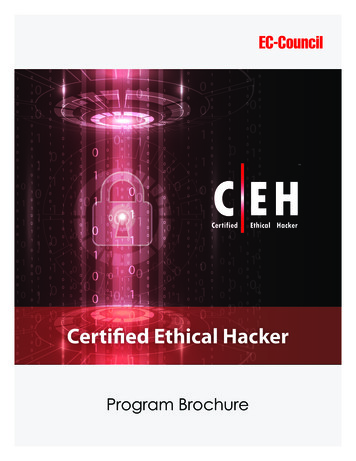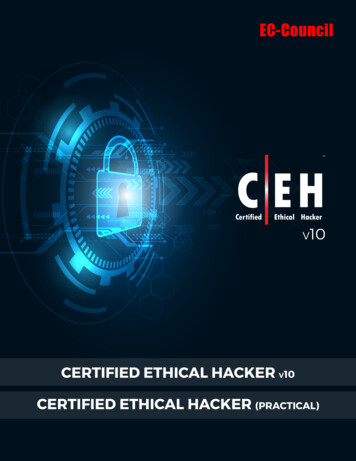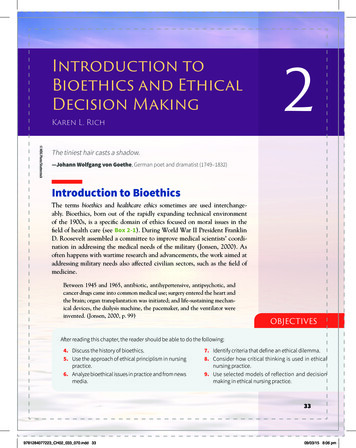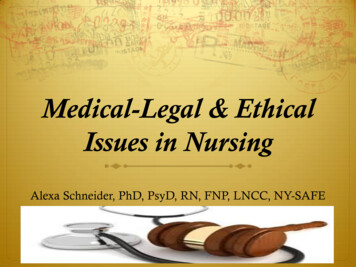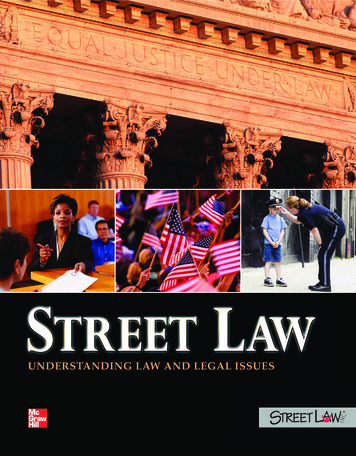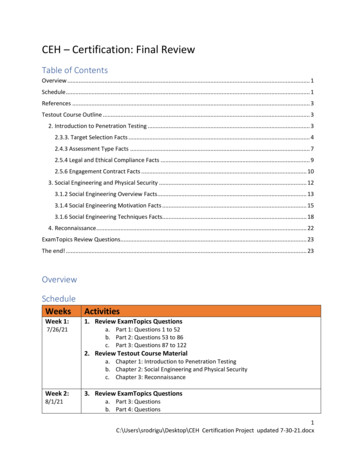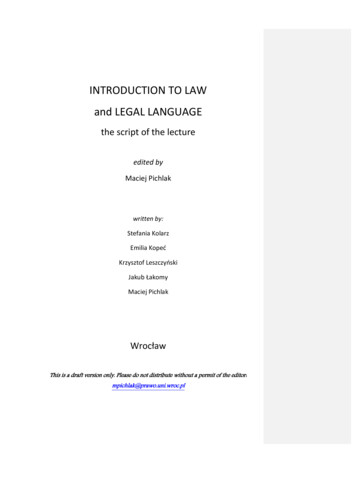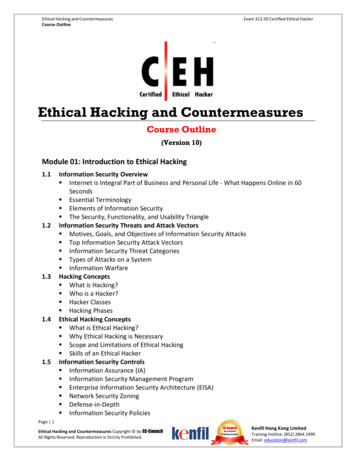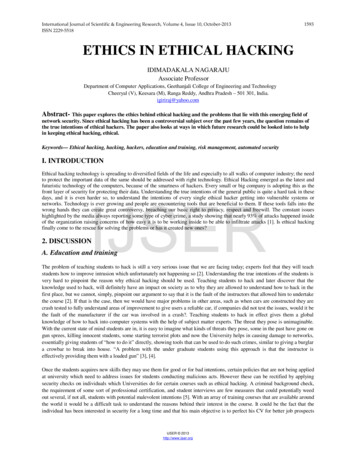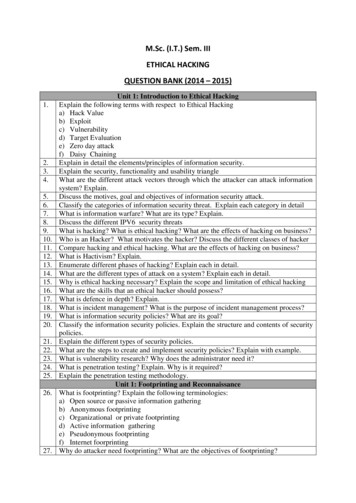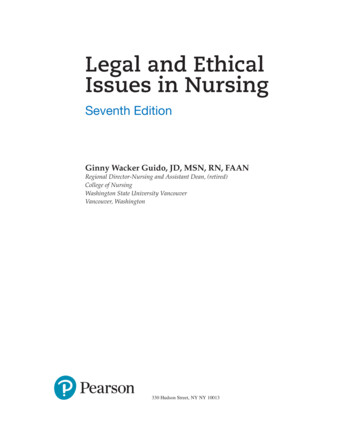
Transcription
Legal and EthicalIssues in NursingSeventh EditionGinny Wacker Guido, JD, MSN, RN, FAANRegional Director-Nursing and Assistant Dean, (retired)College of NursingWashington State University VancouverVancouver, Washington330 Hudson Street, NY NY 10013A01 GUID1233 07 SE FM.indd 111/10/18 6:18 PM
Senior Vice President, Portfolio Management:Adam JaworskiDirector, Portfolio Management: Katrin BeacomPortfolio Manager: Pamela FullerDevelopment Editor: Jill Rembetski,ID8TripleSSS PressContent Producer: Erin SullivanVice President, Content Production and Digital Studio: Paul DeLucaManaging Producer, Health Science: Melissa BasheProject Monitor: Elizabeth C. Elesteria,SPi GlobalOperations Specialist: Maura Zaldivar-GarciaCreative Digital Lead: Mary SienerDirector, Digital Production: Amy PeltierDigital Studio Producer, REVEL ande-text 2.0: Jeff HennDigital Content Team Lead: Brian PrybellaVice President, Product Marketing: Brad ParkinsVice President, Field Marketing: David GesellExecutive Product Marketing Manager:Christopher BarrySr. Field Marketing Manager: Brittany HammondFull-Service Project Management and Composition:Yohalakshmi Segar, Integra Software ServicesInventory Manager: Vatche DemirdjianManager, Rights & Permissions: Gina CheselkaCover Design: Studio MontageCover Art: ShutterstockPrinter/Binder: LSC Communications, Inc.Cover Printer: Phoenix Color/HagerstownCopyright 2020, 2014, 2010 by Pearson Education, Inc. All Rights Reserved. Manufactured in the United Statesof America. This publication is protected by copyright, and permission should be obtained from the publisherprior to any prohibited reproduction, storage in a retrieval system, or transmission in any form or by any means,electronic, mechanical, photocopying, recording, or otherwise. For information regarding permissions, requestforms, and the appropriate contacts within the Pearson Education Global Rights and Permissions department,please visit www.pearsoned.com/permissions.Acknowledgments of third-party content appear on the appropriate page within the text.Unless otherwise indicated herein, any third-party trademarks, logos, or icons that may appear in this work are theproperty of their respective owners, and any references to third-party trademarks, logos, icons, or other trade dressare for demonstrative or descriptive purposes only. Such references are not intended to imply any sponsorship,endorsement, authorization, or promotion of Pearson’s products by the owners of such marks, or any relationshipbetween the owner and Pearson Education, Inc., authors, licensees, or distributors.Library of Congress Cataloging-in-Publication DataNames: Guido, Ginny Wacker, author.Title: Legal and ethical issues in nursing / Ginny Wacker Guido, JD, MSN, RN,FAAN, Regional Director-Nursing and Assistant Dean, College of Nursing,Washington State University, Vancouver, Washington.Description: Seventh edition. Upper Saddle River, New Jersey : PearsonEducation, Inc., [2020] Includes bibliographical references and index.Identifiers: LCCN 2018038475 ISBN 9780134701233 ISBN 0134701232Subjects: LCSH: Nursing—Law and legislation—United States. Nursingethics—United States.Classification: LCC KF2915.N8 G85 2020 DDC 344.7304/14—dc23LC record available at https://lccn.loc.gov/2018038475119ISBN 10:0-13-470123-2ISBN 13: 978-0-13-470123-3A01 GUID1233 07 SE FM.indd 211/10/18 6:18 PM
About the AuthorGinny Wacker Guido has been active in legal and ethicalissues in nursing for all of her professional life. She developed an interest in these areas of nursing while shewas teaching undergraduate nursing students in southern Texas, and her excitement for further knowledge andunderstanding of these content areas encouraged her topursue a doctorate of jurisprudence degree and attendmultiple ethical conferences. Over her career, she continued to attend national and regional workshops and conferences, updating and expanding her knowledge baseregarding both the legal and ethical aspects of professionalnursing practice. Dr. Guido has authored numerous ublications and presented conferences and lectures onplegal and ethical issues in nursing, with special emphasis on a variety of clinical practice settings. In additionto publishing seven editions of Legal and Ethical Issues inNursing, she also edited a text on nursing care at the endof life. She remained active in nursing education until herretirement from Washington State University Vancouverin May 2014. Since her retirement, Dr. Guido continuesto review legal and ethical articles for the Journal of NursePractitioner, reads extensively on current legal and ethicalissues affecting the professional practice of nursing, andhas authored this latest text.iiiA01 GUID1233 07 SE FM.indd 311/10/18 6:18 PM
This book is lovingly dedicated to my family:Ed, Jenny, Joseph, Alexa, and Archer GuidoandCecelia G. WackerA01 GUID1233 07 SE FM.indd 411/10/18 6:18 PM
Thank YouOur heartfelt thanks go out to our colleagues from schoolsof nursing across the country who have given their timegenerously to help create this exciting new text. These individuals helped us plan and shape our text and resources.Legal and Ethical Issues in Nursing has reaped the benefit ofyour collective knowledge and experience as nurses andteachers, and we have improved the materials due to yourefforts, suggestions, objections, endorsements, and inspiration. Among those who gave their time generously to helpus are the following:Diane Daddario, DNP, ANP-C, ACNS-BC,RN-BC, CMSRNNursing FacultyPennsylvania State UniversityUniversity Park, PennsylvaniaLynn R. Dykstra, MS, RN, CHPNInstructorNorthern Illinois UniversityDeKalb, IllinoisPeggy Flannigan, PhD, RNAssociate Chairperson, Department of NursingBradley UniversityPeoria, IllinoisCheryl L. Lang, MSNed, RN, CNENurse Case ManagerManifestations Nurse NavigatorUniversity Hospitals of ColoradovA01 GUID1233 07 SE FM.indd 511/10/18 6:18 PM
PrefaceNew to this Edition Two- or three-part ongoing case studies that assist thereader in applying the chapter content, beginning withChapter 5 Expanded ethical scenarios that assist the reader inbetter incorporating legal and ethical content Addition of organizational ethics in Chapter 3 Expanded decision-making guidelines in Chapter 17 The electronic edition of the text rather than the moretraditional paper editionAs with previous editions of the text, the seventh editionof Legal and Ethical Issues in Nursing reflects the continuedinfluence that law and ethics have on the professionalpractice of the discipline of nursing. This influence maybe seen in the expanding autonomous roles of nurses in avariety of clinical settings, changes in the health care delivery structure and client base, increased accountability andresponsibility at all levels of nursing, and the developmentof newer educational programs for nurses, including themandate for doctoral degrees for advanced practice nurses.This edition, like its predecessors, is written for thepracticing nurse as well as for individuals studying in formal programs of nursing. The text addresses legal and ethical concepts and their application and is appropriate for anyclinical practice site. It is envisioned as both a learning tooland a resource for professionals. As in previous editions,the reader is cautioned that this text is not intended to takethe place of procuring advice and counsel from practicingattorneys and agency legal services. Rather it is meant toaugment the role of attorneys and legal counsel in assistingnurses to better understand the legal process and the interplay of ethics within this legal context. It is hoped that thisimproved understanding of legal and ethical issues will assist nurses in their clinical judgments and interactions withpatients, family members, and their peers.With each edition, familiar and popular features ofprevious editions have been retained and new features orcontent added. Popular features that have been retainedinclude the multiple legal exercises and ethical scenariosthat assist the reader in understanding and applying content areas. Key terms, objectives for the chapter, guidelines,chapter previews and summaries, and the “You Be theJudge/Ethicist” features have been retained. The new features include the incorporation of an ongoing case studyin the majority of chapters, intended to assist the readerboth in applying the content of the chapter and also in understanding how the content could impact the reader in acontinuous manner.As in previous editions, the text is divided into fiveseparate parts. Part 1 addresses the law, the legal system, and the judicial process; the role of the nurse in legalmatters; and the importance of case law in developing standards of nursing care. Part 2 outlines ethical theoriesand principles, the role of ethics committees and organizational ethics, and addresses the application of ethics innursing settings, including moral distress, moral resilience,the role of advocacy within nursing, and the applicationof therapeutic jurisprudence. Part 3 presents liability issuesthat can and do affect nurses in all clinical arenas, concluding with a chapter on professional liability insurance. Part 4contains multiple chapters presenting how the law impacts professional nursing practice, beginning with nursepractice acts and the scope of nursing practice. Subsequentchapters in this part address the issues of advanced practice nursing roles, employment and federal laws that affectnursing practice, the role of the nurse manager, and laws asthey pertain to delegation and supervision. Part 5 appliesthe impact of the law to specific clinical areas, includingacute care, ambulatory and managed health care settings,public and community health, and long-term and homehealth care settings.I am always amazed at how much I have learned in theprocess of revising this text. It is my continued hope thatyou too will continue to learn and apply this knowledge asyou care for the patients that you encounter.Ginny Wacker Guido, JD, MSN, RN, FAANviA01 GUID1233 07 SE FM.indd 611/10/18 6:18 PM
Contents2About the Author iiiThank You vPreface viPart I Introduction to the Law andthe Judicial Process 11Legal Concepts and the JudicialProcess 1Learning Objectives 1Preview 1Key Terms 1Definition of Law 2Sources of Law Constitutional Law Statutory Laws Administrative Laws 2233 Exercise 1–1 3Attorney General’s Opinions 4Judicial Laws 4Classifications (Types) of Law Common Law Civil Law Public Law Criminal Law 55555Exercise 1–2 7Substantive Law 7Procedural Law 7Due Process of Law and Equal Protection of the Law 7The Judicial Process Questions of Law or Fact 88Jurisdiction of the Courts 9State Courts Trial Courts State Appellate Courts State Supreme Courts 10101010 Exercise 1–3 10Federal Courts District Courts Courts of Appeal Supreme Court Exercise 1–4 11Statutes of Limitations 1010111111Exercise 1–5 13Summary 13 Apply Your Legal Knowledge 13 You be the Judge 14 Questions 14 References 14Anatomy of a Lawsuit 15Learning Objectives 15Preview 15Key Terms 15The Trial Process Step One: Initiation of the Lawsuit 1616 Exercise 2–1 19Step Two: Pleadings and Pretrial Motions 19Step Three: Pretrial Discovery of Evidence 20Step Four: The Trial 22 Exercise 2–2 24Step Five: Appeals 24Step Six: Execution of Judgment 24Expert and Lay Witnesses Lay Witness Expert Witness 252525Exercise 2–3 28Summary 28 You be the JudgeQuestions 29 References 2929 Part II Ethics in Nursing Practice 3Introduction to Ethics 3131Learning Objectives 31Preview 31Key Terms 31Definitions of Ethics and Values 32Distinction Between Ethics and the Law 32Ethical Theories 33 Ethical Scenario 3–1: Making Difficult EthicalDecisions 35Ethical Principles 35Autonomy 35Beneficence 36Nonmaleficence 36Veracity 36Fidelity 37Paternalism 37Justice 37Respect for Others 38 Ethical Scenario 3–2: Identifying Ethical Principles 38Ethics Committees 38Organizational Ethics 39 Ethical Scenario 3–3: Exploring Ethics Committees Summary 40 Apply Your Ethical KnowledgeYou be the Ethicist 41 Questions 41 References 414040 viiA01 GUID1233 07 SE FM.indd 711/10/18 6:18 PM
viii Contents4Application of Ethics in NursingPractice Settings 42Learning Objectives 42Preview 42Key Terms 436Tort Law 67Learning Objectives 67Preview 67Key Terms 67Definition of Torts 6868Professional Codes of Ethics 43Negligence Versus Malpractice Ethical Decision-Making Frameworks 43 4445Elements of Malpractice or Negligence Duty Owed the Patient 46 Ethical Scenario 6–1: Ethics of AlternateEmployment 70Breach of Duty Owed the Patient 70Foreseeability 71Causation 72Tests for Causation 73Proximate Cause 74 Case Study, Part I 75Injury 75 Exercise 6–2 76Damages 76 Ethical Scenario 6–2: The Ethics of DamageAwards 78 Exercise 6–3 79 Ethical Scenario 4–1: Using the MORAL Model Advocacy as a Nursing Role Ethical Scenario 4–2: Advocacy Models Moral Distress 46Ethical Scenario 4–3: When Care AppearsMedically Inappropriate 48Therapeutic Jurisprudence 48Slippery Slope Arguments 49Health Policy 50 Ethical Scenario 4–4: Assisting EmergencyDepartment Patients More Effectively Summary 51 Apply Your Ethical KnowledgeYou be the Judge 51 Questions 51 References 525051 Part III Liability Issues 53Standards of Care 535Learning Objectives 53Preview 53Key Terms 53Definition of Standards of Care 53Exercise 5–1 54Establishment of Nursing Standards of Care Internal Standards 5454 Ethical Scenario 5–1: The Hectic EmergencyCenter 56 Case Study, Part I External Standards Exercise 5–2 615757National and Local Standards of Care 61 Case Study, Part II 61 Ethical Scenario 5–2: Meeting the MinimalStandard of Care 61Importance of Standards of Care to the Individual Nurse Case Study, Part III Exercise 5–3 64Expert Testimony 64Expanded Nursing Roles 64 Exercise 5–4 64Selected Ethical Issues and Standards of Care Summary 65 You be the JudgeQuestions 66 References 66A01 GUID1233 07 SE FM.indd 865 Doctrine of Res Ipsa Loquitur 65Ethical Scenario 6–3: The Doctrine of ResIpsa Loquitur Locality Rule Case Study, Part II Avoiding Malpractice Claims 69697980818181Exercise 6–4 83Patient Education and Tort Law 83Definition of Intentional Torts 84Intentional Torts 84Assault 84Battery 85 Exercise 6–5 86False Imprisonment 86 Ethical Scenario 6–4: Detaining Patientsagainst Their Wishes Conversion of Property Trespass to Land Intentional Infliction of Emotional Distress 6263Exercise 6–1 69 87888888Exercise 6–6 89Quasi-Intentional Torts 89Invasion of Privacy 89Defamation 90Case Study, Part III 91Defenses 92 Exercise 6–7 92Ethical Issues and Tort Laws 9211/10/18 6:18 PM
ContentsSummary 93 Apply Your Legal Knowledge 93 You be the Judge 94 Questions 94 References 947Nursing Liability: Defenses 96Learning Objectives 96Preview 96Key Terms 96Defenses Against Liability 97Defenses Against Intentional Torts 97Consent 97Self-Defense and Defense of Others 97Necessity 98Defenses Against Quasi-Intentional Torts 98Consent 98 Case Study, Part I 99Truth 99Privilege 100Disclosure Statutes 100 Exercise 7–1 101Access Laws 103Qualified Privilege 103 Ethical Scenario 7–1: References and Ethical Responsibilities 104Defenses Against Nonintentional Torts 104Release 104Contributory and Comparative Negligence 104 Case Study, Part II 106 Exercise 7–2 106Assumption of the Risk 106Unavoidable Accident 107Defense of the Fact 107 Case Study, Part III 107Immunity 107Good Samaritan Laws 107 Ethical Scenario 7–2: Being a Good Samaritan 109Statutes of Limitations 109Products Liability 109Collective and Alternative Liability 110Caveats in Products Liability Lawsuits 111 Exercise 7–3 111Selected Ethical Issues Summary 111 Apply Your Legal Knowledge You be the Judge 112 Questions 112 References 1128Informed Consent 111112Learning Objectives 114Preview 114Key Terms 114A01 GUID1233 07 SE FM.indd 9Role of Consent 115Consent Versus Informed Consent 115Inclusions in Informed Consent 115Forms of Informed Consent 116Standards of Informed Consent 117 Ethical Scenario 8–1: Limitation on InformedConsent 118 Exercise 8–1 118Exceptions to Informed Consent 118Accountability for Obtaining Informed Consent Nurses’ Role in Obtaining Consent 119120 Case Study, Part I 121Consent Forms 121Exercise 8–2 123Who Must Consent 123Competent Adult 123Incompetent Adult 123Minors 124 Exercise 8–3 125Right to Refuse Consent Limitations on Refusal of Therapy 126126Ethical Scenario 8–2: A Patient Who RefusesBlood Products 127Law Enforcement 127Informed Consent in Human Experimentation 127 Case Study, Part II 130Health Literacy 130Genetic Testing 130 Patient Education in Genetic Testing 131Case Study, Part III 131Selected Ethical Issues in Informed Consent Summary 132 Apply Your Legal KnowledgeYou be the Judge 133 Questions 133 References 1339132133 Patient Self-Determination 135Learning Objectives 135Preview 135Key Terms 135Patient Self-Determination 136The Issue of Consent 136Living Wills 137Natural Death Acts 138 114ixExercise 9–1 139Durable Power of Attorney for Health Care Third-Generation Advance Directives Case Study, Part I Uniform Rights of the Terminally Ill Act Physician Orders for Life-Sustaining Treatment 13914014114114111/10/18 6:18 PM
x ContentsPatient Self-Determination Act of 1990 Do-Not-Resuscitate Directives 142Exercise 9–2 144Case Study, Part II Mature Minors and the Right to Die 172144 Case Study, Part II Exercise 10–4 173145Electronic Transfer of Medical Records 174146Confidentiality of Medical Records 174Ethical Scenario 9–1: The Child with Cancer Exercise 9–3 146Assisted Suicide 171Incident Reports 145 Hospice Care Access to Medical Records 146172 Exercise 10–5 174 Case Study, Part III Health Insurance Portability and AccountabilityAct of 1996 Electronic Mail and the Internet 147175175178 Case Study, Part III 148 Ethical Scenario 9–2: When Advance Directivesare Disregarded 148Reporting and Access Laws 178148Common-Law Duty to Disclose Contagious Diseases Threats to an Identified Person 179179179Ethical Issues Summary 149 Apply Your Legal Knowledge 149 You be the Judge 150 Questions 150 References 15010 Documentation and Confidentiality 152Learning Objectives 152Preview 152Key Terms 152Medical Records 153Contents of the Record 153Effective Documentation Make an Entry for Every Observation 153153 Exercise 10–1 156Follow-Up as Needed 156 Ethical Scenario 10–1: James Darling’s Care Read Nurses’ Notes before Giving Care Always Make an Entry, Even If It Is Late Make the Chart Entry after the Event Use Clear and Objective Language Exercise 10–2 161Be Realistic and Factual Case Study, Part I Chart Only Your Own Observations Chart Patient’s Refusal for Care Clearly Chart All Patient Education Correct Charting Errors Never Alter a Record at Someone Else’s Request Identify Yourself after Every Entry Use Standardized Checklists or Flow Sheets Leave No Room for Liability 161162162162163163164164165166Exercise 10–3 166Electronic Medical Record (Computerized Charting) 156157158160160Ethical Scenario 10–2: The Ethics of theMedical Record 166180Limitations to Disclosure Substance and Alcohol Abuse Confidentiality HIV/AIDS Confidentiality 180180181Selected Ethical Concerns 181 Ethical Scenario 10–4: The Ethics ofDocumentation 182Summary 182 Apply Your Legal KnowledgeYou be the Judge 183 Questions 183 References 18311183 Professional Liability Insurance 185Learning Objectives 185Preview 185Key Terms 185Professional Liability Insurance 186Insurance Policies 186Types of Policies 186 Exercise 11–I 187Declarations 187Coverage Agreements Limits and Deductibles Case Study, Part I Additional Clauses in Insurance Policies 187187187188Exercise 11–2 189Licensure Protection 189Individual Versus Employer Liability Coverage 192 Exercise 11–3 192Reasons to Purchase Individual Liability Insurance 167Ethical Scenario 10–3: Ethical Duty to Warn Case Study, Part II 192193Charting by Exception 168Arguments for Having Professional LiabilityInsurance 193Alteration of Records 168 Retention of Records 169Ownership of the Record 170A01 GUID1233 07 SE FM.indd 10Ethical Scenario 11–1: Professional LiabilityCoverage 194Selected Ethical Issues 19411/10/18 6:18 PM
ContentsSummary 194 Apply Your Legal KnowledgeYou be the Judge 195 Questions 195 References 19513194 Part IV Impact of the Law on the Professional Practice of Nursing 19612Nurse Practice Acts, Licensure,and the Scope of Practice 196Learning Objectives 196Preview 196Key Terms 196Advanced Nursing Practice Roles Historical Overview of Advanced Nursing Practice Roles Nurse Anesthetist Nurse Midwifery Advanced Nurse Practitioners Clinical Nurse Specialist Clinical Nurse Leader Doctor of Nursing Practice Professional Licensure State Boards of Nursing Mandatory Licensure Permissive Licensure Institutional Licensure 226Case Study, Part II Reimbursement Issues Malpractice Issues 227227227Case Study, Part III 200200Exercise 13–2 232Exercise 12–2 200 200Exercise 12–3 207Penalties for Practicing Without a License 207207Ethical Scenario 12–1: The Recovering Nurse 208 Case Study, Part II 208Articulation of Medical Practice Acts 209Scope of Practice Issues 209Ethical Scenario 12–2: Duty to Promote Health Updating Nurse Practice Acts Continuing Education for Practicing Nurses Ethical Scenario 12–3: Education for Nurses 210Complementary and Alternative Medicine Case Study, Part III 215Mutual Recognition Compacts 215Selected Ethical Concerns 216Summary 217 Apply Your Legal Knowledge 218 You be the Judge 218 Questions 218 ReferencesA01 GUID1233 07 SE FM.indd 11219232Exercise 13–3 233233Statute of Limitations 233Ethical Perspectives and Advanced Nursing Practice 233 Exercise 13–4 234Summary 234 Apply Your Legal Knowledge You be the Judge 234 Questions 235 References 23514Corporate Liability Issues and Employment Laws 234237Learning Objectives 237Preview 237Key Terms 237Theories of Vicarious Liability Respondeat Superior 238238 Ethical Scenario 14–1: The Duling Case Scope and Course of Employment Exercise 14–1 241Borrowed Servant and Dual Servant Doctrines 241214Medicinal Use of Cannabis (Marijuana) 232Ethical Scenario 13–2: Transgender HealthServices 232Direct Access to Patient Populations 212215231Admitting (Hospital) Privileges 213Exercise 12–4 214228Prescriptive Authority 212Reporting Professional Violations of the NursePractice Act 213Certification 214 Ethical Scenario 13–1: Advance Practice Roles Diversion Programs 224200Case Study, Part I Exemptions 201Licensure across Jurisdictions 202Disciplinary Action and Due Process Requirements 202 224Standards of Care Requirements for Licensure Case Study, Part I 199Elements of Nurse Practice Acts Definition of Professional Nursing 224Scope of Practice Issues Exercise 12–1 199Nurse Practice Acts 221221221222222223223Exercise 13–1 224Credentials 197 220Learning Objectives 220Preview 220Key Terms 220Legal Liability of Expanded Nursing Roles 197197198198199xiCorporate Liability Negligent Hiring and Retention 238239241242Ostensible Authority 242Subjectivism 24311/10/18 6:18 PM
xii ContentsInherent Function 243Reliance 243Control 243 Ethical Scenario 14–2: Ostensible Agency 243Theories of Independent Liability 243Independent Contractor Status 243Personal Liability 244Indemnification 244 Exercise 14–2 244Employment Laws 244Equal Employment Opportunity Laws 244 Exercise 14–3 250Federal Torts Claims Act of 1946 250Age Discrimination in Employment Act of 1967 250Provisions of the ADA Title I Title II Title III Title IV Title V 274274275275275275Lawsuits Under the ADA Disability Discrimination 275275 Ethical Scenario 15–1: Enactment of the ADA 276 Case Study, Part I Reasonable Accommodation 278279 Ethical Scenario 15–2: ReasonableAccommodation 280 Exercise 15–2 281Essential Job Functions 282Case Study, Part I 251Rehabilitation Act of 1973 251 Case Study, Part II Affirmative Action 252 Occupational Safety and Health Act 252Employment-at-will and Wrongful Discharge 253Exercise 15–3 283Pre-Employment Activities 283Cases Under Titles III and IV 283Enforcement of the ADA 284 Exercise 14–4 255 Case Study, Part II 256 Ethical Scenario 14–3: The Whistleblower Case 256 Ethical Scenario 14–4: The Winkler CountyNurses Case 257 Exercise 14–5 258Collective Bargaining 259Case Law and the National Labor Relations Act 262 Exercise 14–6 264Family and Medical Leave Act of 1993 Case Study, Part III Workers’ Compensation Laws Exercise 14–7 266267Ethical Concerns in This Area of the Law 267Summary 268 Apply Your Legal Knowledge 268 You be the Judge 268 Questions 269 References 269Federal Laws: The Americans with Disabilities Act of 1990 and theCivil Rights Act of 1991 272Exercise 15–4 285Civil Rights Act of 1991 Background of the Act Definition of Sexual Harassment Quid Pro Quo Sexual Harassment Case Study, Part III Hostile Work Environment 285285285285286286Ethical Scenario 15–3: Sexual HarassmentLaws 288Preferential Treatment or Sexual Favoritism 288Exercise 15–5 289Ethical Concerns 289 Summary 289 Apply Your Legal KnowledgeYou be the Judge 290 Questions 290 References 29016290 Nursing Management and theNurse-Manager 292Liability 293 Case Study, Part I Exercise 16–1 294Causes of Malpractice for Nurse-Managers 273273273Exercise 15–1 274Exclusions from the Definition of Disability 274A01 GUID1233 07 SE FM.indd 12285Learning Objectives 292Preview 292Key Terms 292Learning Objectives 272Preview 272Key Terms 272The Americans with Disabilities Act of 1990 Background of the Act Definitions in the Act 265Patient Protection and Affordable Care Act andHealth Care and Education Reconciliation Act 15ADA Summary 264266282 Ethical Scenario 16–1: Ethical Obligations andthe Role of Nurse-Managers Duty to Orient, Educate, and Evaluate Failure to Warn Hiring Practices 294295295295297297Exercise 16–2 29711/10/18 6:18 PM
ContentsStaffing Issues Adequate Numbers of Staff Exercise 16–3 300 Ethical Scenario 16–2: Employment Dilemmas Float Staff Agency Personnel 300301303 Case Study, Part II 304 Exercise 16–4 305Policies and Procedures 305Contract Principles Legal Elements of a Contract 306306Types of Contracts 306 Exercise 16–5 307Termination of a Contract 308 Ethical Scenario 16–3: Contracts and Ethics 309 Case Study, Part III 309Alternative Dispute Resolution 309Mediation 309Arbitration 309Fact Finding 309Summary Jury Trial 309Nurses and Contracts 309Exercise 16–6 310Contracts that Arise After Employment 17310311 Delegation, Supervision, andSelected Patient Advocacy Issues 313Learning Objectives 330Preview 330Key Terms 331Acute Care Nursing 331Patient Safety 331Psychiatric and Vulnerable Patients Suicide Prevention 332332 Case Study, Part I 333 Ethical Scenario 18–1: The 15-Minute Checks 335 Exercise 18–1 336Warning of Intent to Harm 336Failure to Protect from Harm 337False Imprisonment/Wrongful Commitment 339 Case Study, Part II Level of Care Required Confidentiality Right of Mentally Ill Patients Exercise 18–2 342 Ethical Scenario 18–2: To Restrain the Patient orNot to Restrain the Patient 344Exercise 18–3 346317 Ethical Scenario 18–3: Medication Administration 349318 Exercise 18–4 350Failure to Document Appropriately 350Ethical Scenario 17–1: The Absent Nurse Unlicensed Assistive Personnel 341341342318314Exercise 17–1 316Case Study, Part I 330Medication Errors Incorrect Patient Incorrect Dosage, Medication, or IncorrectRoute of Administration Improper Injection Technique Incorrect Time of Administration Failure to Note Patient Allergies Inaccurate Knowledge Regarding the Medicationand Its Side Effects Principles of Effective Delegation Nursing in Acute Care Settings Restraints 342 18 Learning Objectives 313Preview 313Key Terms 313Delegation, Assignment, and Supervision 328 Part V Impact of the Law onNursing in Selected PracticeSettings 330310Ethical Issues Summary 311 Apply Your Legal KnowledgeYou be the Judge 311 Questions 312 References 312Summary 328 Apply Your Legal KnowledgeYou be the Judge 328 Questions 329 References 329298298xiii317347348348349349 Case Study, Part II Exercise 17–2 320Patient Falls Ethical Scenario 17–2: A Lack of Supervision 321 Ethical Scenario 18–4: When a Patient Falls 322 Exercise 18–5 352Patient Advocacy 320346346 Ethical Scenario 17–3: Advocating in a TimelyManner 323 Exercise 17–3 324 Exercise 17–4 325 Case Study, Part III Specific Challenges to Patient Advocacy Ethical Considerations A01 GUID1233 07 SE FM.indd 13326327327Technology and Equipment 350351352Failure to Adequately Assess, Monitor, andCommunicate 353Failure to Monitor 354Failure to Assess and Communicate 355 Exercise 18–6 358Failure to Listen and Communicate with Patients 35911/10/18 6:18 PM
xiv Contents Case Study, Part III Communicating with Culturally and EthnicallyDiverse Individuals 359359Exercise 18–7 360Failure to Act as a Patient Advocate 361Patient Education 361 Ethical Scenario 18–5: Patient Teaching Ethical Issues in Acute Care Settings 361Nursing in Ambulatory andManaged Care Settings 366Learning Objectives 366Preview 366Key Terms 367Ambulatory Care Nursing Patient Education Distance Delivery of Health Care 367367368 Case Study, Part I 370 Ethical Scenario 19–1: Telenursing 371 Exercise 19–1 371Violence 372 Exercise 19–2 374Volunteer Services 374Donating Health-Related Advice 375 Case Study, Part II Managed Health Care Organizations Ethical Scenario 19–2: The Patient-CenteredMedical Home Model Legal Issues Surrounding Managed Care Employment Retirement Income Security Act Summary 393 Apply Your Legal KnowledgeYou be the Judge 394 Questions 394 References 39420392393394 Public and Community HealthCare 396Learning Objectives 396Preview 396Key Terms 396Overview of Public and Community Health Nursing 397Federal Statutes Social Securit
legal and ethical issues in nursing, with special empha-sis on a variety of clinical practice settings. In addition to publishing seven editions of Legal and Ethical Issues in Nursing, she also edited a text on nursing care at the end of life. She remained active in nursing education until

